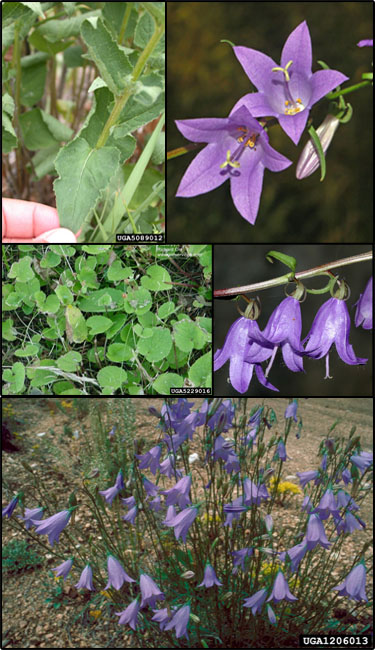Rampion bellflower (Campanula rapunculoides)
 Common Names: Creeping bellflower, Rover bellflower
Common Names: Creeping bellflower, Rover bellflowerDescription: The leaves and roots are edible and in Russia, has been used as a cure for hydrophobia.
Habit: Erect; perennial; little branched; rhizomatous.
Leaves: Alternate, 5 in long and 2 in across, lower leaves are long-stalked, heart shaped, coarsely-toothed margins; Upper leaves sessile, lanced shaped.
Stems: Light green to reddish brown in color; glabrous to slightly hairy; and terete or angular.
Flowers: Light purple in color, borne in the axils of the upper leaves, occur along one side of stem, 5 united sepals, 5 united petals.
Fruit and seeds: Round capsule containing numerous small, elliptical, light brown seeds with small wings; produces 3000 seeds or more annually.
Habitat: Native to Europe. Grows well in areas of moist soils.
Reproduction: By seed and occasionally from the long rhizomes.
Similar species: Native Harebells (Campanula rotundifolia).
Monitoring and rapid response: Hand pulling or cutting and bagging flower spikes pre-bloom; glyphosate is effective for spot applications, dicamba for larger infestations. Credits: The information provided in this factsheet was gathered from Illinoiswildflowers.info, Invasiveplants.ab.ca and the USDA PLANTS Database.
Individual species images that appear with a number in a black box are courtesy of the Bugwood.org network (http://www.invasive.org).Individual photo author credits may not be included due to the small display size of the images and subsequent difficulty of reading the provided text. All other images appear courtesy of Google (http://images.google.com).
Common Name: | Rampion bellflower |
Scientific Name: | Campanula rapunculoides |
Family: | Campanulaceae (Bellflower) |
Duration: | Perennial |
Habit: | Herbs |
USDA Symbol: | CARA |
